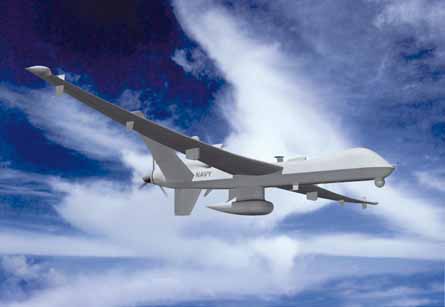Lockheed Martin says modified General Atomics Predator B will exceed US Navy's operating requirements
Lockheed Martin and General Atomics Aeronautical Systems are emphasising low acquisition and operating costs as they offer a development of the MQ-9 Predator B turboprop-powered unmanned air vehicle for the US Navy's Broad Area Maritime Surveillance competition.
With a higher weight and larger wing to carry extra fuel for longer endurance, the Mariner system exceeds the navy's key requirement for effective time on station (ETOS), says Chuck Martello, Lockheed senior business development manager, unmanned systems.
|
|---|
Manufacturers are pushing the UAV's low purchase and operating costs |
The USN requires 80% ETOS at 3,700km (2,000nm) with three or fewer aircraft aloft at one time. Martello says the 230kt (425km/h) Mariner, with an endurance of 48h, provides 94% ETOS at 3,700km with three vehicles aloft: one on station, one en route and one returning. Even if the UAV has to descend below weather to identify ships, ETOS is still 90%, he says.
Martello believes a round-the-clock orbit can be maintained with as few as five vehicles, including two on the ground, and does not believe competitor Northrop Grumman will be able to meet the requirement with substantially fewer of its more expensive RQ-4 Global Hawk UAVs. The third BAMS candidate is a derivative of the Gulfstream G550 business jet proposed by Boeing, details of which are scarce.
The Mariner uses the Predator B's fuselage, avionics, flight controls and 1,000shp (745kW) Honeywell TPE331-10 turboprop. Wing span is increased from 20.1m (66ft) to 26.8m and take-off gross weight from 4,080kg (9,000lb) to 5,900kg to carry an additional 907kg of fuel, giving a ferry range of 13,000km. Internal payload is 612kg, with 363kg growth, and external payload is 1,810kg.
Mission equipment includes a FLIR Systems electro-optical/infrared sensor in a retractable turret, and an EDO 360°-scan multi-mode maritime radar. The Mariner also carries electronic support measures, a ship identification system, and narrowband and wideband line-of-sight and satellite communications links. An onboard maritime mission processor will manage bandwidth use, says Martello.
Award of a development contract is expected by the end of September, with BAMS expected to become operational in 2013-14, as an unmanned adjunct to the USN's Boeing P-8 Multi-mission Maritime Aircraft. The navy needs enough systems to provide five orbits to support fleets deployed around the world.
Source: Flight International
























